Contrast radiology–not a dying art (Proceedings)
A medical contrast medium (or contrast agent) is a substance used to enhance the contrast of structures or fluids within the body in medical imaging.
Definition: A medical contrast medium (or contrast agent) is a substance used to enhance the contrast of structures or fluids within the body in medical imaging.
Agents used most frequently:
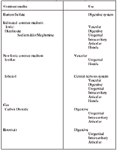
Studies to be discussed:
• Digestive system
• Urogenital system
• Intra-cavitary
• Water soluble iodinated contrast medium-
o ionic and non-ionic
o non-ionic tend to me less toxic
o basic configuation of all of them-benzene ring that has iodine attached to it.
http://en.wikipedia.org/wiki/Radiocontrast
http://hsc.uwe.ac.uk/idis2/contrast_agents/CM%20Zip/ContrastMedia_Schering.pdf
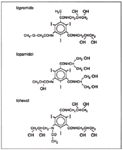
High osmolar (ionic) Ionic contrast media have higher osmolarity and more side-effects

Commonly used iodinated contrast agents
Low osmolar (non-ionic)

Commonly used iodinated contrast agents
Non-ionic contrast media, have lower osmolarity and tend to have less side-effects, such as Omnipaque, Ultravist, Visipaque, etc.

Commonly used iodinated contrast agents
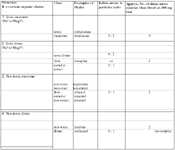
Barium (gastro-intestinal)
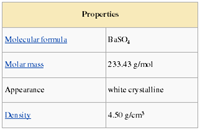
Properties
Digestive system
What I have learned from doing digestive system contrast studies:
o Be positive about the procedure even if you use negative contrast medium.
o Prepare the patient and the owner.
o You cannot determine esophageal motility status if the pet is sedated or anesthetized.
o You may not be able to determine gastric or bowel motility status if the pet is sedated or anesthetized.
o Administer the contrast medium any place in the hospital except with the patient on the x-ray table.
o If you get barium on your clothing-especially the shoes-wash it off immediately as it is much harder to remove later on.
o A barium/contrast study is either normal or abnormal.
o If it is normal-be happy for the patient-however, it does not mean the GI system is normal.
o If it is abnormal-decide if it is related to a non-obstructive or an obstructive disease process:
Non obstructive:
√ Altered bowel dynamics
√ Bowel not pathologically distended.
√ Bowel wall thickened
√ Bowel mucosa irregular
√ Barium flocculates
Obstructive:
√ Pathological distention of the bowel
√ Contrast may not traverse the bowel
o Twenty-five percent of the time your exploratory will not reveal a definitive lesion-then biopsy the bowel!
o A negative contrast gastrogram is a good way to define gastric pliability, wall thickness/contour and gastric luminal content.
o A barium enema is a good way to distinguish between the large and small bowel.
o Endoscopy, ultrasound and exploratory surgery are often required to make a definitive diagnosis.
Esophogram:
o No sedation or anesthesia
o Obtain survey lateral and VD or VD oblique radiographic projections.
o Place contrast in oral cavity and allow animal to swallow it
o Contrast- General evaluation-Barium sulfate-1 ml/lb. If you suspect esophageal perforation use water soluble medium
o Any water soluble iodinated contrast medium should be good- 1 ml/lb.
o Repeat the radiographic projections immediately
Negeative Contrst Gastrogram:
o Sedation recommended:
√ Acepromazine IV in Dogs
√ Ketamine/Valium IV or SQ in cats
o Obtain survey lateral and VD radiographic projections
o Pass the orogastric tube
o Inflate the stomach with room air—6 ml/lb
o Remove the tube and repeat the radiographic projections.
Positive Contrast Gastrointestinal Series:
o If sedation needed use acepromazine IV in dogs and ketamine/valium in cats
o Obtain survey lateral and VD radiographic projections.
o Place contrast in the esophagus or into the stomach with an orograstric tube
o Contrast- General evaluation-use barium sulfate-4ml/lb
If suspect GI perforation use water soluble iodinated contrast medium-2 ml/lb
o Radiographic projections repeated after contrast administration at the following times
o General comments:
√ A GI series is not completed until a lesion is defined or the majority of the contrast has traversed the bowel. In the canine, radiographs may need to be taken eight hours post-contrast administration or the next day and in the cat, radiographs may need to be taken two hours post-contrast administration to complete the study.
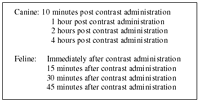
Urogenital
Intravenous urogram:
o Make sure colon and urinary bladder are empty
o Obtain survey lateral and VD radiographs
o Place a catheter in the cephalic vein
o Place a catheter in the urinary bladder
o Inject water soluble contrast medium intravenously-1ml/lb
o Obtain radiographs within one to two minutes after injection (lateral, VD and oblique projections as needed)
o Distended the urinary bladder with gas-4ml/lb
o Obtain radiographs five minutes after the bladder is distended (lateral, VD and oblique projections as needed)
o Obtain radiographs ten-fifteen minutes after bladder is distended.
Negative contrast cystogram:
o Make sure the colon is empty
o Obtain survey lateral and VD oblique radiographs
o Place catheter in the urinary bladder
o Distend the bladder with gas-4 ml/lb.
o Obtain lateral and VD oblique radiographs
Positive contrast cystogram
o Make sure the colon is empty
o Obtain survey lateral and VD oblique radiographs
o Place catheter in the urinary bladder
o Distend the bladder with water soluble iodinated contrast medium –2 ml/lb.
o Obtain lateral and VD oblique radiographs
Double contrast cystogram
o Make sure the colon is empty
o Obtain survey lateral and VD oblique radiographs
o Place catheter in the urinary bladder
o Place a small amount of water soluble iodinated contrast medium into the bladder 1 ml for cat, 2 ml for small dog, 3 ml for medium size dog, 4 ml for large size dog or 5 ml for giant size dog (note this is total volume, not per pound)
o Distend the urinary bladder with gas-4 ml/lb
o Obtain lateral and VD oblique radiographs
Positive contrast urethrogram:
o Make sure the colon is empty
o Obtain survey lateral and VD oblique radiographs
o Fill the catheter with positive contrast medium
o Place the catheter into terminal portion of urethra
o Secure the catheter in place
o Inject positive contrast medium 5 ml for small dog or cat10 ml for medium size dog; 15 ml for large or giant size dog
o Obtain lateral radiograph while completing injection
o Repeat the injection
o Take VD oblique radiograph while completing the injection
Positive contrast vaginogram
o Make sure the colon is empty
o Obtain survey lateral and VD oblique radiographs
o Fill the catheter with positive contrast medium
o Place the catheter into terminal portion of the vagina
o Secure the catheter in place
o Inject positive contrast medium 5 ml for small dog or cat10 ml for medium size dog; 15 ml for large or giant size dog
o Obtain lateral radiograph while completing injection
o Obtain VD oblique radiograph.
Positive Contrast Peritoneogram
o Obtain survey lateral and VD radiographs
o Sedate the animal
o Place a catheter into the abdominal cavity-catheter should be inserted adjacent to the umbilicus and just to the right of the midline.
o Inject sterile water soluble contrast medium into the peritoneal cavity-1 ml/lb
o Remove the catheter
o Massage the abdomen to distribute the contrast medium.
o Obtain lateral and VD or DV radiographs.
General comments:
o If free fluid is present in the abdomen, remove as much of the fluid as you can before injecting the positive contrast medium
o If you suspect a hernia, position the animal for three minutes so that the positive contrast medium will flow towards the suspected hernia site.
o The positive contrast medium will be absorbed and you will eventually see it in the kidneys and urinary bladder.
Veterinary scene down under: Australia welcomes first mobile CT scanner, and more news
June 25th 2024Updates on the launch of the first mobile CT scanner available for Australian pets; and learn about the innovative device which simplifies placement of urinary catheters in female dogs
Read More